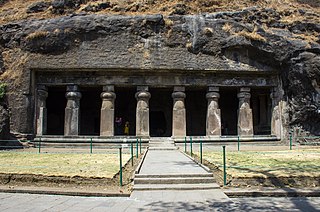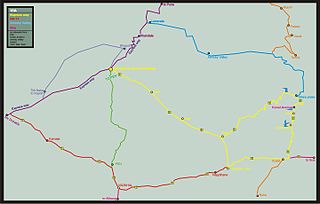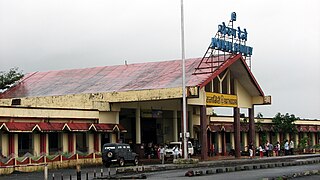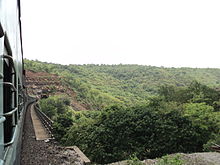
Transport in India consists of transport by land, water and air. Road transport is the primary mode of transport for most Indian citizens, and India's road transport systems are among the most heavily used in the world.

Roha is a town and taluka in the Raigad district of the Maharashtra state of India. It is located 120 km southeast of Mumbai. It is the starting point of Konkan railways and end point of central railways (Mumbai). Many chemical industries have opened up their manufacturing bases in Roha. Roha is located between the banks of the Kundalika River and the hills of Kalasgiri. It has a population of over 20,849. Roha is connected to Mumbai by Panvel-Roha railway line. Roha is also the northern end of the Konkan Railway. Roha is off of the Mumbai Goa Highway, via the Kolad road.
Panvel is a city and taluka in Raigad district of Maharashtra, India. It is highly populated due to its closeness to Mumbai. Panvel is also governed for development purpose by the body of Mumbai Metropolitan Region. Panvel Municipal Corporation is the first Municipal Corporation in Raigad and the 27th Municipal corporation of Maharashtra State.

Konkan Railway Corporation Limited (KRCL) is an Indian public sector undertaking which operates Konkan Railway and also undertakes other railway-related projects. It is wholly-owned by the Government of India under the administrative control of the Ministry of Railways and headquartered at CBD Belapur in Navi Mumbai. The railway (railroad) route of KRCL covers the coastal districts of Maharashtra, Goa and Karnataka states of India.
Kudal is a census town in Sindhudurg district, Maharashtra, India. It is situated on River Karli in southwest Maharashtara. Kudal is the fourth largest town in Sindhudurg after Sawantwadi, Malvan and Kankavli. As of 2011, the population is 16,015. Kudal supports one MIDC area in the Konkan division. The Kudal railway station is located on the Konkan Railway route and connects the town with Mumbai metro situated in the Bombay, Baroda and Central India Railway of the north, and Mangalore on the south. It is a major stop for the Konkan Railway. The Deccan Odyssey train also stops in Kudal. National Highway 66 passes through Kudal. Apart from that, it also has two bus stations, a new one and old one. The old one is situated in market while the new one is just adjacent to the NH-66. Kudal is situated in centre of the Sindhudurg district and also considered one of the fastest-growing towns in the Konkan region. The Desai's were the original rulers of Kudal, who were tributaries of the Bijapur Sultanate, later the Marathas and then under the British.

Raigad district, previously Colaba district, is a district in the Konkan division of Maharashtra, India. The headquarters of the district is Alibag. Other major cities in the district are Panvel, Karjat, Navi Mumbai, Khopoli, Shrivardhan and Mahad.
Sawantwadi is a taluka in the Sindhudurg district in the Indian state of Maharashtra. The taluka headquarters is Sawantwadi which has a municipal council, which is a local civic body. Sawantwadi was formerly the capital of the Kingdom of Sawantwadi, ruled by the Sawant Bhonsle royal clan of the Marathas.

The Udhampur-Srinagar-Baramulla Rail Link(USBRL) is a railway track being laid to connect the Kashmir Valley in the Indian union territory of Jammu and Kashmir with Udhampur and thence to the rest of the country. The 338 km railway track will start from Udhampur and end at Baramulla. It comes under the jurisdiction of the Firozpur railway division of Indian Railways' Northern zone. The 359 m (1,178 ft) tall Chenab Bridge lies on this line, which is the tallest railway bridge in the world. The total project cost in 2022 was INR28,000 crore.

The 12619/20 Matsyagandha Superfast Express is a daily Superfast Express train running between Lokmanya Tilak Terminus (Mumbai) and Mangaluru Central. The train was introduced on 1 May 1998 as Mangalore-Kurla Express. The Matsyagandha Express travels through some of the very difficult terrains of India. Matsyagandha Express travelling from Lokmanya Tilak Terminus, Mumbai (LTT) to Mangaluru Central became first train to take Roha-Veer double line on Konkan railway route on 30 August 2021 at 7.30p.m.

Karnataka, a state in South India has a well-developed transport system. Its capital city, Bengaluru is well-connected by air to domestic and international destinations and the Kempegowda International Airport (KIA) in the city is one of the busiest airports in India. It was also the headquarters of the airlines Air Deccan and Kingfisher Airlines. The road transport is also well developed in the state with many National and State highways providing means for fast transportation. The headquarters of the South-Western Railway division of Indian Railways is located at Hubballi and this division governs most of the railway network in the state. Konkan Railway which passes along the coastal region of the state is considered one of the toughest engineering projects being undertaken in India till date. Buses, cars and trains are the means of transport for moving across distant places in Karnataka. For transportation within the city or town limits; motorbikes, cars, autorickshaws and buses are used. With the advent of low-cost airlines, many people are choosing to travel via air as well.

Kolad is a village in Raigad district, Maharashtra State, India. It is 117 km from Mumbai on the National Highway no 66(Mumbai-Goa) its also connected to Pune via Kolad Pune- Kolad state highway. It lies on the banks of River Kundalika. The village post office Postal Index Number is 402304 & 402109.
Mangalore's location in the Indian state of Karnataka makes it accessible by all forms of transport: road, rail, air and sea. It is the largest city in the Coastal Karnataka region, and is the only city in Karnataka and one among the six cities in India to have an International Airport, a Major Seaport, railway & road connectivities. It is the second prominent city of Karnataka after the state capital Bangalore in all aspects. It is one of the fastest developing cities in India.

Mangaluru Central railway station is the main railway terminus in the city of Mangalore which lies in the heart of the city. It is one of the major railway stations in Karnataka state and it is the biggest terminal station under Palakkad railway division. There is also another railway station named Mangalore Junction railway station, previously known as Kankanady railway station. The Mangalore region provides the highest freight revenue to the Palakkad division, which sums up to 90 percent of the total revenue which the Palakkad division generates. Mangalore Central comes under the Southern Railway and also provides connectivity for Konkan Railway and South Western Railway of the Indian Railways. It is one of the 5 central railway stations of India.

Madgaon Junction Railway Station is a railway junction and major station on the Indian Railways network, specifically on the South Western Railway line to Vasco da Gama, Goa and the Konkan Railway, in Madgaon, Goa, India. The station is progressing by getting electrified and double-tracked with the addition of new platforms.

Mangaluru Junction railway station, formerly Kankanadi railway station is an important railway station connecting Konkan, Western Ghat and Malabar railways and is also the gateway to the port city of Mangaluru located at Darbar Hill, Padil, Mangaluru, 575007, coming under the Palakkad Division of Southern Railway. The station is a junction interconnecting Mangalore Central railway station with Kerala in the south, Maharashtra/Goa and Mangalore Sea Port in the north and Bengaluru–Chennai in the east. It is the busiest railway junction in the area, as all north- and southbound trains touch Mangalore through this station.
Maharashtra is a state in western India. It is the country's second-most-populous state and third-largest state by area. Maharashtra is bordered by the Arabian Sea on the west, Gujarat and the Union territory of Dadra and Nagar Haveli on the northwest, Madhya Pradesh on the north and northeast, Chhattisgarh on the east, Karnataka on the south, Telangana on the southeast and Goa on the southwest. The state covers 307,731 km2 (118,816 sq mi), or 9.84 percent of India's total area.

Ratnagiri railway station (RN) is a train station that serves the city of Ratnagiri in the Indian state of Maharashtra. It is the one of the main railway stations of the Konkan Railway. The station has modern facilities like elevator and escalator. The station offers free Wi-Fi. All Konkan Railway trains halt at Ratnagiri. It is 7 km away from the city. It falls under the Ratnagiri railway division.

Kolad railway station is the first railway station on the Konkan Railway. It is at a distance of 12.916 km down from Roha railway station which comes under Konkan Railway. The succeeding station is Indapur railway station, a halt station.

Surathkal railway station is one of the main railway stations of Mangalore city along with Mangalore Central railway station and Mangalore Junction railway station and is located in north Mangaluru. Twenty-two trains stop here.KRCL operates RO-RO services from Suratkal to Verna, Kolad, and Karembeli. As per the Konkan railway map, Surathkal railway station is at a distance of 733.825 kilometers from the northern starting point of the Konkan railway line at Roha and 4.615 kilometers from Thokur which is the southern endpoint of Konkan railway jurisdiction. The Surathkal railway station is at distance of 26.285 Kilometre from Mangaluru Central(MAQ) railway station.

Mookambika Road Byndoor is a railway station in coastal Karnataka in South India. Its four-letter code is BYNR. Mookambika Road Byndoor is the main railway station in the town of Byndoor in Udupi district. It serves Byndoor city which is 1 kilometre away from the station. It is the nearest railway station to the famous pilgrimage centre, Kollur Mookambika temple. The distance from Byndoor railway station to Kollur Mookambika temple is about 28 km which can be covered in 40 minutes to one hour by road. Trains from here connect the city to prominent state capitals of India like Bangalore (Karnataka), Thiruvananthapuram, Mumbai and so forth. It is also well connected to the major railway stations such as Goa (Madgoan), Udupi, Mangalore, Kasaragod and Ernakulam. Rail connectivity in Byndoor was established in 1997. A total of 34 express and passenger trains halt here; there was one originating and terminating trains at this station: Mookambika Road–Kannur Passenger train; however this service was terminated in 2017 within two years of service due to lack of revenue generation. Although the railway station caters to a lot of passengers and superfast trains on a daily basis, it does not have a siding line or passing loop. Any crossing of trains can only happen either on Bijoor or Shiroor railway stations 19 km apart.























